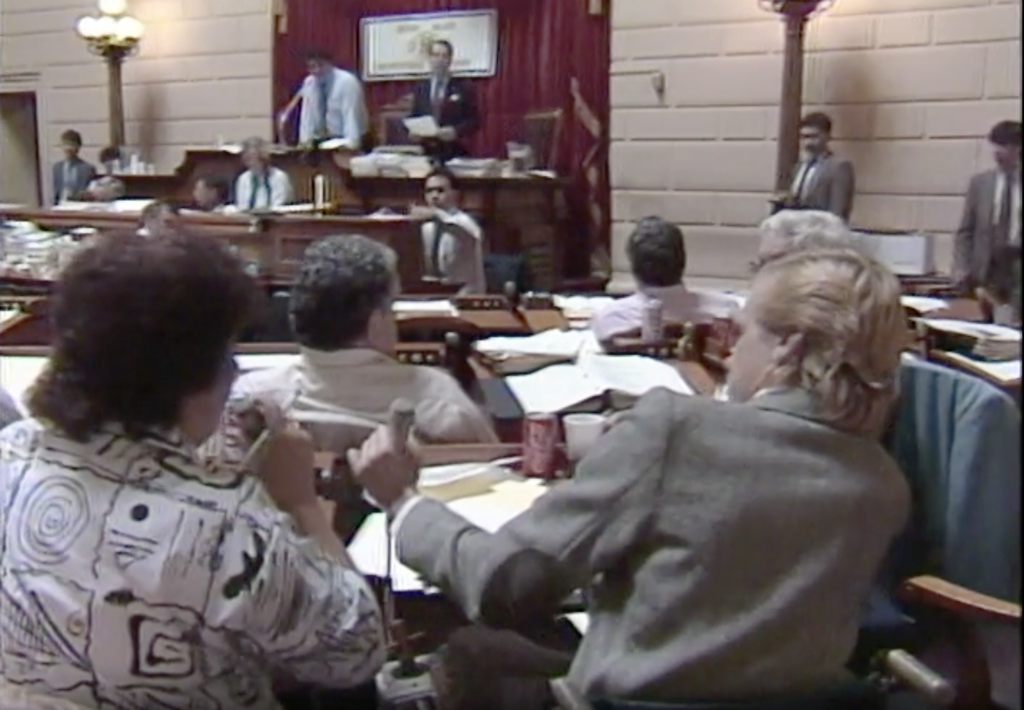Rhode Island Constitutional Convention Delegate and Secretary James Langevin, right foreground, takes the microphone to address the convention during a session on June 11, 1986. The last time Rhode Island had a constitutional convention was 1986. (Still from Rhode Island Archives)
Who are the major funders of state constitutional convention referendums? The leaders of Rhode Island’s coalition opposing a convention, RI Citizens for Responsible Government, report that “wealthy special interests,” including “out-of-state” and “dark money” interests, support convention referendums. However, the evidence shows the opposite.
Rhode Island’s “no” coalition does make some valid general observations about funding for ballot measures:
1) The wealthy can spend unlimited amounts of money on referendums (but they have been allowed to since 1978, not 2010, as the “no” coalition claims.)
2) Large amounts of money have been spent trying to influence referendums.
3) Money can influence referendum results.
But when the coalition compares “no” and “yes” campaigns, it gets its facts backward.
“No” campaigns far outspend “yes” campaigns. In fact, “no” campaigns are backed by the most powerful special interest groups in each state. And “no” campaigns are also backed by out-of-state interests — mostly national organizations supporting their state affiliates.
Consider Alaska in 2022, the last election cycle with a convention referendum.
The “no” side raised $4.8 million, the “yes” side $61,600, for a 78:1 advantage for the “yes” side. Since political science demonstrates that a ballot measure campaign dollar spent defending the status quo is much more effective than one spent proposing change, the 78:1 nominal advantage greatly underestimates the effective advantage.
On a per capita basis, the “no” campaign was the most expensive “no” campaign among all the 140 ballot measures across the U.S. On a per capita basis, it also had the largest amount of out-of-state and dark money.
What Question 1 will look like on the Nov. 5, 2024, ballot. (Rhode Island Secretary of State Voter Guide)
The combined out-of-state and dark money represented 67.4% of the total “no” spending and all came from the D.C.-based Sixteen Thirty Fund, which is run by a former National Education Association political operative. The in-state money predominantly came from local unions, especially unions representing government employees. For the “yes” campaign, the money predominantly came from individuals, with the largest “yes” contribution ($10,000) only 0.002 times the size of the largest “no” contribution ($3.2 million).
Stop using history to shoot down a constitutional convention
In Rhode Island in 2014, the last time the convention referendum was on the ballot, the “no” side contributed $151,800 and the “yes” side $41,500, a 3.7 advantage. As in Alaska, the predominant “no” funders and organizers were unions and the predominant “yes” funders were individuals. Rhode Island hasn’t had an Alaska-style dark money problem; it has primarily had a disclosure enforcement problem — a campaign finance system that favors the wealthy and powerful over everyone else who, for example, cannot afford the high legal costs required to enforce the law.
As of Oct. 16, 2024, the “no” coalition had raised $119,700 for campaign advertising, including $15,000 from the out-of-state National Education Association, according to campaign finance reports filed with the Rhode Island Board of Elections. No “yes” campaign currently exists.
A major difference between the “no” and “yes” sides concerns the leadup to a referendum when polls indicate the “yes” side might win. Here the “no” side seems to be able to spend whatever it takes to secure a win whereas the “yes” side cannot. This may be because unions, such as the National Education Association, keep a large fund to provide its local affiliates with support in such a situation.
“No” campaigns far outspend “yes” campaigns. In fact, “no’ campaigns are backed by the most powerful special interest groups in each state.
What explains the imbalance in campaign finance between the “yes” and “no” campaigns? One explanation involves the democratic function of the convention process, which, like the ballot initiative (which Rhode Island lacks), is to bypass the legislature’s monopoly gatekeeping power. This makes not only legislatures but the special interest groups that excel at influencing legislatures into the natural enemies of the convention process. A second explanation is that improving government infrastructure — the core function of the convention process — is a quintessentially public good, so suffers from severe collective action problems. An analogy is the different collective action problems faced by producers (e.g., airlines) vs. consumers (e.g., passengers); the former are well organized and funded, the latter not so. Similarly, “no” sides are better funded and organized than “yes” sides.
From the late 19th to early 20th centuries, big business primarily organized “no” campaigns. Beginning in the late 20th century, it became big labor. Big business still plays a major role opposing conventions in Republican states; much less so in Democratic ones such as Rhode Island.
To really understand who would benefit from a convention, look no farther than who funds and orchestrates ‘no” campaigns. Claims inconsistent with this funding data are Machiavellian politics. After the 2004 referendum, the Providence Journal’s editorial page editor Edward Achorn convincingly argued the “no” campaign not only successfully hid its funding but did so because timely revealing it could have caused it to lose the close election. His insights are as relevant today as they were then.
GET THE MORNING HEADLINES.

